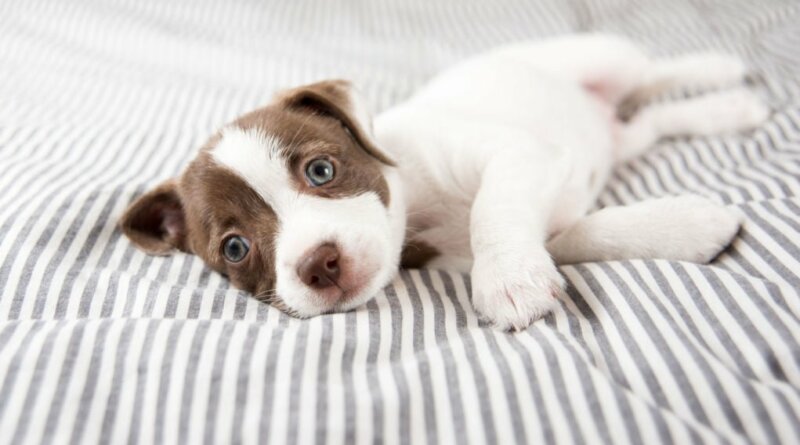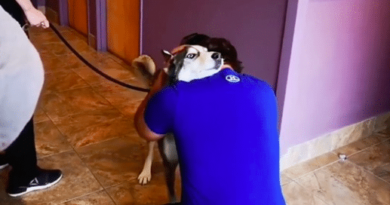How Do You Pick a Calm Puppy – Top Dog Tips
Looking for a puppy that won’t make you run around the house like crazy? We are here to help!
Adopting a dog is a long-term commitment! This makes choosing the right puppy that matches your personality and can quickly settle into the family essential.
Well, needless to say, calm puppies are the best for homeowners, especially beginners.
It is highly probable that they will grow into docile adults and won’t make you mad through their “puppyhood”!
So, how do you pick a calm puppy?
Honestly, there is no one-size-fits-all explanation for it! But we have some tips and techniques to help you decide.
This post will discuss the three best ways to pick a calm puppy.
You will learn to observe puppy temperament and personality, and we will discuss calmer dog breeds to help you pick a buddy easily.
So, let’s begin, shall we?
3 Best Ways to Pick a Calm Puppy
There is no perfect way to pick a calm puppy. However, we have narrowed it down to the three best ways to make the selection easier for parents-to-be!
- Observe puppy behavior in the litter.
- Do one-on-one personality testing.
- Look for calmer dog breeds.
Below we will discuss each area in detail!
What are Puppy Temperaments?
When you are surrounded by tumbling little puppies in a litter, it is hard to choose THE ONE!
Just like humans, every puppy has a different temperament. Even no two siblings are alike!
Choosing the most pretty little furry baby is tempting, but the cute one is not always calm. You got to go fur-deep to find a lovely, sweet pup.
So, as a prospective puppy parent, we suggest you analyze the puppy’s temperament.
A puppy aptitude test is an excellent way to analyze the dog’s temperament, making it easy to pick the calm one.
Six Types of Puppy Temperaments
Experts have narrowed down puppy personalities/temperaments into six types.
Some are social, some dominant, while others are calm and shy. Each puppy would more or less fall into one of these types.
Here are the six personality types of puppies and their main characteristics:
1. Dominant + Aggressive
These types of puppies have the alpha bossy temperament. Also, they show aggressive behavior. This personality type is challenging to socialize.
These puppies are better suited for someone with proper training and experience in dog behavior management.
2. Dominant + Active
These puppies also have alpha personalities but don’t usually display intense aggression. They are active and distracted quite easily.
A confident and patient puppy parent can better train and socialize with this personality type.
3. Independent
As the name indicates, the puppies with this personality category like to do things independently.
They are not much into cuddling and are stubborn and strong-willed.
These are best for parents who have to be away from home for extended periods. They are okay to be left alone for 7-8 hours.
4. Affectionate
Affectionate puppies are very friendly. They are fast learners and want to be around people.
Also, they like to give and receive love. Affectionate puppies are great if you are into cuddling and playing.
5. Calm/Docile
The calm puppies are pretty laid-back. They are loyal and gentle.
You can say they are “chill” dogs who would lie in your lap quietly. Also, such puppies are well-behaved around kids and family members.
These puppies will make an excellent addition to parents who want to bring a dog home with their kids.
6. Shy/Fearful
The fearful puppies display signs of anxiety and lack confidence. They are not good at socializing and get frightened quickly.
A loving and committed parenting style can suit the personality of these puppies.
RELATED: Different Types of Dog Temperaments
How Can I Determine the Temperament of the Puppy?
The best way to determine the temperament of a puppy is through a personality test.
The core function of a personality test is to look for specific signs that indicate a particular character (We’ll get to these signs shortly!).
A personality test tells you how the puppy will:
- View the world
- Interact with humans, other dogs, or animals
- Behave in general
- Respond to activities and behavior training
- Spend energy
Age of Personality Testing in Puppies
The ideal age of personality testing for puppies is 7-9 weeks. The puppy’s personality develops fully at around eight weeks of age.
Testing done before seven weeks will not show accurate results as the puppies are not fully mature.
Similarly, personality testing in older age dogs will yield only some results. In this case, the dogs are big enough to mask their traits.
Selecting a pup between 7-9 weeks is better. We always recommend in-person testing when selecting a puppy.
Method of Personality Testing in Puppies
The primary method of personality testing in puppies is to observe their behavior. You should visit a shelter or shop and check the puppy’s interaction in its litter.
See how the puppy plays, eats, and deals with others, including the staff.
Based on the observation, you can look for specific signs that belong to a temperament/ personality category.
The following behaviors are common to each personality type:
Signs of Dominant Personality Type
- Showing aggressive behavior with other pups, usually by leaping, mounting, or leaning on them
- Stealing treats, toys, or food
- Acting possessive with treats or food
- Often display rough play with growling and teething
Signs of Independent Personality Type
- Are okay to play alone or be away from siblings
- Wander off and explore on their own
- Do not like to steal toys or food but are happy with what they get
- Like to sit at a side and enjoy the play or activity from a distance
Signs of Shy/Submissive Personality Type
- You can usually find the pup near its mother.
- Is easily picked on or pushed around by other puppies
- Often found at the bottom of the heap
- Cannot handle conflict and rolls over to show its tummy
- Easily gives up toys or treats and doesn’t fight back
Signs of Calm Personality Type
- The calm pup is neither aggressive nor shy.
- They like to stay in the middle of the pack and play with their siblings.
- Don’t fight or steal toys and treats.
- Don’t try to dominate the fearful puppies.
- They enjoy the company of their parent and also like alone time.
The next time you visit a shelter or shop, try to look for these signs to quickly identify the personality type of each puppy.
Learn more about puppy personality traits and types in our detailed post on dog personalities!
Remember: The puppies do not see you watching them. Try to do it in an UNOBSERVED manner.
Once the puppies realize you are watching, they might get excited and change their behavior.
Always corroborate your observation with the staff for complete behavior identification. Ask questions and share your information.
Since they see the puppies every single day, they can better guide you to a perfect match.
How to Identify a Calm Puppy with One-On-One Testing
Once you feel drawn to a pup after observation, it’s time to test them one-on-one. The individual testing will reveal more about their personality.
You can then choose a puppy who has traits of a calm nature.
Note: For one-on-one testing, it is better to take the puppy away from the litter (preferably to a quiet place).
Test 1: A Gentle Stroke
Put the puppy down on the ground and bend in front of them. Stroke the puppy gently but firmly.
Start from the head and move towards the back to finally at the rear end. Repeat the process until the dog shows a significant reaction.
A calm puppy will not enjoy it at first. They might wiggle, whine or freeze.
But a docile pup will eventually relax and get close to your hand. They may even try to lick it.
Test 2: Direct Eye Contact
Pick up the puppy and hold it in your arm like a baby. Place one hand firmly on the chest and give direct eye contact. Keep in mind that the gaze should not be threatening.
A calm and docile pup will not object much to the eye-contact. They will remain steady in your arms.
Test 3: Check Socialization
Put the puppy on the ground and let it wander off for 30-40 seconds. Ignore until the pup is busy with its own thing and not paying attention.
Then crouch down and call the pup towards you. Encourage the pup to come and hold out your arms.
A calm pup would be happy to come back. They will come in a relaxed manner and may even try to lick your hands and face.
Note: Check that the puppy should not be too pushy. Jumping, nibbling, or pawing might indicate dominant behavior.
Test 4: Lift the Pup off the Ground
With the puppy in front of you, hold it from under the belly. Lift up, so the pup’s feet are a few inches above the ground level.
Hold it firmly in this position for about 30 seconds.
A docile puppy will not struggle much, just some wriggling at first. Later, the pup will remain calm and might even lick your hand.
Also, watch puppy testing with a live demonstration in this YouTube video:
Note: Separating a puppy from its litter can make the pup act out and show signs of aggression. Read our guide on Dog Litter Separation to learn about making this a smooth transition!
Top 5 Calm Dog Breeds
Breed genetics also come into play when you want to pick out a furry partner who knows when to behave.
Calm dog breeds strike a balance between lazy and highly energetic puppies.
They are not couch potatoes and also don’t possess energy so high that they jump off the walls.
So, here is a roundup of the 5 best calm dog breeds to choose a puppy from:

English Bulldog
Before you move on from a hefty bulldog, considering it lazy, think again!
English bulldogs make great companions. They are one of the sweetest, kind, and most passive dog breeds.
Plus, they welcome exercise to get in shape and stay trimmed.
French Bulldog
A French bulldog or “Frenchie” is bred down from smaller bulldog breeds. These dogs can adjust to just any lifestyle.
They are happy to lie down all day and nap or spend the afternoon playing in the park. They make the best companions around children and families.
Another upside is their small size. Weighing roughly 28 pounds, these dogs are easy to take for car drives and outings.
Great Pyrenees
Although the Great Pyrenees are giant majestic mountain dogs, they are known for their peaceful and calm nature.
People once used them to protect sheep in snowy mountains, and they still retain their protective instincts. You will find this breed extraordinarily loyal and caring.
You will have to provide a little training to the Pyrenees for riding in a car and playing around children. But once trained, they will be on their best behavior.
Greyhound
You might recognize a Greyhound for its speed and agility but trust us; they are super calm at home!
They are well-mannered, loyal, and patient and take less space than expected from their long build.
Golden Retriever
Golden Retrievers are the most popular dog breeds in the U.S. due to their intelligent, calm, and playful personalities.
They display good behavior and bond well with others members of the family. They also like activities and will accompany you on jogs and hikes.
Remember: The breeds mentioned above have low-key temperaments, but the puppy traits are still different from adult dogs.
Just like children, puppies tend to be more energetic and playful in their early years. They will become calmer as they age.
RELATED: 20 Most Friendly Dog Breeds!
How Do You Pick a Calm Puppy: Final Words
This article contains techniques on how to pick a calm puppy. First, observe the behavior of the puppies in the litter.
Check for signs that give you a clue about their temperament type.
Second, do one-on-one testing with the puppies you feel drawn to from the litter.
Finally, try to pick a pup from a calmer breed, as they are more likely to grow into peaceful, docile adults.
Do remember that puppies at early ages are more playful and active. So, it’s better to ask the advice of the staff as well.
READ NEXT: How Do You Check a Dog’s Temperament?












